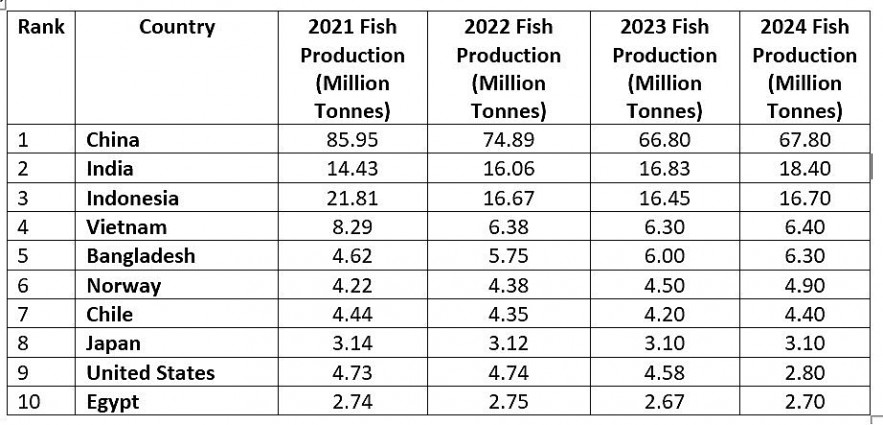India Becomes World's 2nd Largest Fish Producer
India has solidified its position as the second-largest fish-producing nation, contributing approximately 8% of the global fish production. Over the past two decades, India's fisheries sector has experienced remarkable growth and transformation. Technological advancements, policy reforms, and strategic initiatives have propelled the sector forward, cementing the country's status as a global leader in aquaculture and seafood exports.
Though China continues to dominate global fish production, its output has gradually declined since 2021. India, on the other hand, has experienced significant growth, particularly from 2021 to 2024, securing its position as the second-largest producer. Vietnam and Bangladesh have maintained relatively stable rankings. Norway and Chile maintain strong positions, largely due to their emphasis on aquaculture, particularly salmon farming.
Top 10 countries in fish production
 |
India’s significant breakthrough is attributed to strong growth in both inland and marine fisheries, supported by initiatives such as the Blue Revolution and the Pradhan Mantri Matsya Sampada Yojana (PMMSY).
Rapid growth in fish production
India’s fish production has seen substantial growth in recent years, reaching 184 lakh tons (18.4 Million Tons) in 2023-24, a significant rise from 96 lakh tons (9.6 Million Tons) in 2013-14 and 64 lakh tons (6.4 Million Tons) in 2003-04, marking an increase of 88 lakh tons (8.8 Million Tons) over the past decade compared to a 32 lakh tons (3.2 Million Tons) increase in the previous decade. Inland and aquaculture production witnessed a remarkable surge from 2014-24, with a rise of 78 lakh tons (7.8 Million Tons), compared to 27 lakh tons (2.7 Million Tons) in 2004-14, while marine fish production doubled from 5 lakh tons (0.5 Million Tons) in 2004-14 to 10.5 lakh tons (1.5 Million Tons) in 2014-24. Additionally, seafood exports have soared, with India exporting 18 lakh metric tons (1.8 Million Metric Tons) of seafood worth ₹60,523.89 crore (USD 7 Billion) in 2023-24, a sharp rise from ₹609.95 crore (USD 100 Million) in 2003-04, highlighting the country’s growing prominence in the global seafood market.
The blue revolution and the PMMSY initiative
The Blue Revolution scheme, launched in 2015-16 with a central allocation of ₹3,000 crore (USD 300 Billion) over five years, laid the foundation for making India's fisheries sector more economically viable. However, it was the introduction of the Pradhan Mantri Matsya Sampada Yojana (PMMSY) in 2020 that brought about transformative reforms. With an investment of ₹20,050 crore (USD 2.3 billion), the PMMSY initiative focuses on the development of inland fisheries, aquaculture, and improving food security.
Under the Pradhan Mantri Matsya Sampada Yojana (PMMSY), several key initiatives have been launched to transform the fisheries and aquaculture sectors. These include the establishment of 2,195 Fish Farmers Producer Organisations (FFPOs) with a project cost of ₹544.85 crore (USD 100 Million) to empower fishers and enhance their bargaining power. The Fisheries and Aquaculture Infrastructure Development Fund (FIDF), launched in 2018 with ₹7,522.48 crore (USD 900 Million), has approved 136 projects worth ₹5,801.06 crore (USD 700 Million) to develop fisheries infrastructure. In 2024, the Pradhan Mantri Matsya Kisan Samridhi Sah-Yojana (PMMKSSY) was approved with an estimated ₹6,000 crore (USD 700 Million) to address financial and technological gaps in the sector.
Additionally, 11 integrated aqua parks have been approved with an investment of ₹682.6 crore (USD 100 Million) to strengthen the aquaculture value chain, while the installation of 937 artificial reefs in coastal areas with an investment of ₹291.37 crore (USD 45 Million) will help rejuvenate marine habitats and promote sustainable fishing. The creation of Nucleus Breeding Centres (NBCs) focuses on improving the genetic quality of aquaculture species, ensuring better productivity and seafood quality.
Technological Advancements in Fisheries
Technological advancements have significantly transformed the fisheries sector in India, with innovations such as satellite technology integration, GIS-based resource mapping, and specialized institutions like the ICAR-Central Institute of Fisheries Education (CIFE) playing pivotal roles. Satellite technologies like Oceansat and the Potential Fishing Zones (PFZ) system have revolutionized fishing practices by identifying fish-rich zones and supporting sustainable resource management.
Additionally, the government has employed Geographic Information System (GIS) technology to map marine fish landing centers and fishing grounds, enhancing the efficiency and sustainability of fisheries resource use. CIFE, established in 1961, has been at the forefront of fisheries education, training over 4,000 professionals who are now equipped to promote sustainable practices. Guided by the National Policy on Marine Fisheries (NPMF, 2017), India continues to emphasize sustainability, with policies focused on conserving marine resources and ensuring their responsible management.
Recent developments and support
The Union Budget for 2025-26 continues to demonstrate the nation's commitment to advancing this crucial industry. The budget proposes a record allocation of ₹2,703.67 crore (USD 300 Million), aiming to boost financial inclusion, reduce custom duties, and support the development of marine fisheries, thereby strengthening India’s global competitive position.
A key focus of the budget is on creating a sustainable framework to tap into fisheries resources from the Exclusive Economic Zone (EEZ) and the High Seas, particularly around Lakshadweep and the Andaman and Nicobar Islands, unlocking the untapped potential of marine fish. Additionally, the government has increased the Kisan Credit Card (KCC) lending limit from ₹3 lakh (USD 3400) to ₹5 lakh (USD 5700), enhancing access to credit for fishers, farmers, and processors, ensuring that essential working capital is readily available for continued growth in the sector.
In conclusions, India’s fisheries sector has undergone a remarkable transformation between 2004 and 2024. With strategic investments in infrastructure, technological advancements, and sustainable practices, India has not only increased its fish production but also enhanced the socio-economic well-being of its fishing communities. Moving forward, the focus on innovation, sustainability, and inclusive growth will be strengthening India's upward trajectory in global fish production.
